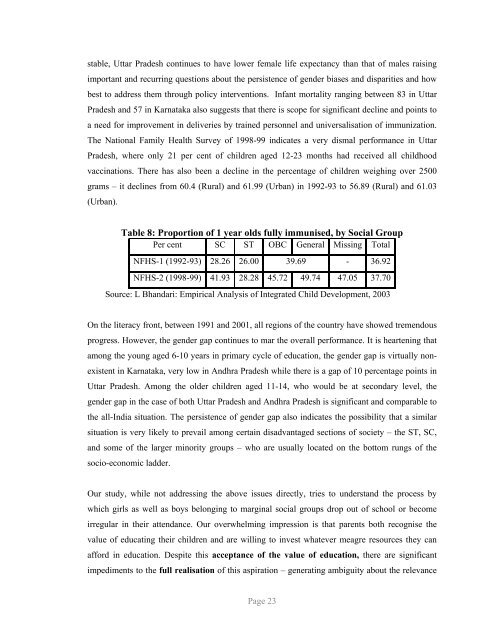Snakes and Ladders - ERU Consultants Pvt. Ltd.
Snakes and Ladders - ERU Consultants Pvt. Ltd.
Snakes and Ladders - ERU Consultants Pvt. Ltd.
You also want an ePaper? Increase the reach of your titles
YUMPU automatically turns print PDFs into web optimized ePapers that Google loves.
stable, Uttar Pradesh continues to have lower female life expectancy than that of males raising<br />
important <strong>and</strong> recurring questions about the persistence of gender biases <strong>and</strong> disparities <strong>and</strong> how<br />
best to address them through policy interventions. Infant mortality ranging between 83 in Uttar<br />
Pradesh <strong>and</strong> 57 in Karnataka also suggests that there is scope for significant decline <strong>and</strong> points to<br />
a need for improvement in deliveries by trained personnel <strong>and</strong> universalisation of immunization.<br />
The National Family Health Survey of 1998-99 indicates a very dismal performance in Uttar<br />
Pradesh, where only 21 per cent of children aged 12-23 months had received all childhood<br />
vaccinations. There has also been a decline in the percentage of children weighing over 2500<br />
grams – it declines from 60.4 (Rural) <strong>and</strong> 61.99 (Urban) in 1992-93 to 56.89 (Rural) <strong>and</strong> 61.03<br />
(Urban).<br />
Table 8: Proportion of 1 year olds fully immunised, by Social Group<br />
Per cent SC ST OBC General Missing Total<br />
NFHS-1 (1992-93) 28.26 26.00 39.69 - 36.92<br />
NFHS-2 (1998-99) 41.93 28.28 45.72 49.74 47.05 37.70<br />
Source: L Bh<strong>and</strong>ari: Empirical Analysis of Integrated Child Development, 2003<br />
On the literacy front, between 1991 <strong>and</strong> 2001, all regions of the country have showed tremendous<br />
progress. However, the gender gap continues to mar the overall performance. It is heartening that<br />
among the young aged 6-10 years in primary cycle of education, the gender gap is virtually non-<br />
existent in Karnataka, very low in Andhra Pradesh while there is a gap of 10 percentage points in<br />
Uttar Pradesh. Among the older children aged 11-14, who would be at secondary level, the<br />
gender gap in the case of both Uttar Pradesh <strong>and</strong> Andhra Pradesh is significant <strong>and</strong> comparable to<br />
the all-India situation. The persistence of gender gap also indicates the possibility that a similar<br />
situation is very likely to prevail among certain disadvantaged sections of society – the ST, SC,<br />
<strong>and</strong> some of the larger minority groups – who are usually located on the bottom rungs of the<br />
socio-economic ladder.<br />
Our study, while not addressing the above issues directly, tries to underst<strong>and</strong> the process by<br />
which girls as well as boys belonging to marginal social groups drop out of school or become<br />
irregular in their attendance. Our overwhelming impression is that parents both recognise the<br />
value of educating their children <strong>and</strong> are willing to invest whatever meagre resources they can<br />
afford in education. Despite this acceptance of the value of education, there are significant<br />
impediments to the full realisation of this aspiration – generating ambiguity about the relevance<br />
Page 23












